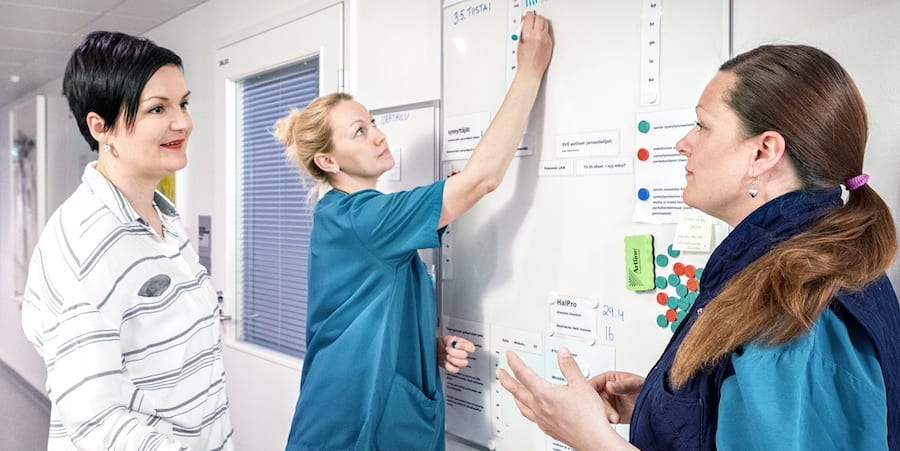
Creativity unleashed
FEATURE – A lean coach from Argentina reflects on the transformations he has supported across Latin America and on why lean can help unlock the potential of the continent.
Words: Nicolás Alejandro Rebozov
A few weeks ago, a friend who is living in Denmark told me she was preparing for an important job interview and that lean experience was one of the requirements. She asked me, “What should I learn about Lean?” My answer was that she should probably familiarize herself with the toolkit – starting with the A3 problem solving. “They will probably ask you about that,” I told her, “even though that’s not really what lean is about and the tools alone will not give you lasting results.”
What is this lean “thing” that can magically improve team motivation and increase productivity? There are many ways of understanding it. Some say it’s a philosophy, some say it’s a way of thinking, some say it’s a strategy. Sadly, many still see as nothing more than a tool for cutting costs and increasing profit. Without getting into the philosophical debate, let’s just say that one thing’s for sure: lean is more than just a bunch of tools.
How do I know? Because when I first started consulting, my approach was to carry out the typical job of analyzing the current situation, providing a diagnosis, and creating an action plan (in other words, the Plan phase of PDCA). As if the Do, Check and Act phases were nothing but an afterthought, I’d leave them as a prerogative of the client organizations, failing to communicate to them that PDCA only makes sense as a complete cycle (a realization I hadn’t made yet myself). The result? No sustainability in the actions taken and results achieved, and everything going back to square 1 shortly after “the project” ended. It didn’t take me long to realize that was not enough for me.
The truth is that our results depend on our ability to solve problems effectively. When there is only one person saying what needs to be done – be it a “superhero” manager or an external coach – instead of effective problem solving across the business, all we get is stress and firefighting. This is so prevalent here in Latin America, where the prevailing managerial style is still that of the boss who has to know it all, lest they lose the respect of their people. What these managers fail to see is that nobody knows everything and, no matter how hard they try to pretend they do, people see right through them.
What to do then? We need to address the problem at the root cause by making a cultural change, involving people and unlocking their inner potential. To achieve that, old paradigms need to be broken and our leadership style needs to be changed, so that the key principles and practices enabling a lean transformation can materialize: respect for people, employee engagement, and Kaizen.
MY EXPERIENCE IN LATIN AMERICA
Thirty years after Lean Thinking was first “codified” and introduced to the world by Jim Womack and Dan Jones, it is surprising to see how die-hard some misconceptions around it can be.
This is certainly still true here in Argentina, where I live, and across Latin America. One big misunderstanding I have noticed, perhaps more often in small- to medium-sized companies, is the belief that people are being productive, if they look busy and are using their hands. Unfortunately, “hand movement” is not a KPI – not a good one, anyway. The failure to deploy proper indicators means that progress can’t be effectively measured, which leads to demotivation, which in turn leads to productivity loss.
Another common misconception in these parts – often used as an excuse for not embracing Lean Thinking – is our alleged lack of discipline. “We are not Japanese,” people often say, as if every single Japanese company was inherently lean and there was some kind of a “lean gene” that we South Americans supposedly lack. This is just self-sabotage: we are not trying to transform a whole country at once, but to bring change to our organizations in the hope that the cumulative effect of our transformations will impact the lives of our people and societies, the way we deliver value to our customers, and our performance. The problem is that a transformation is only possible with a strong baseline of principles and a new culture built on top of it. And, for that, leadership must take 100% responsibility.
Having worked and coached all around the continent, I have noticed that the problems Latin American companies complain about are typically the same: long lead-times, a lack of order in the processes, little to no employee motivation. The reason why these issues appear to be endemic here is that companies don’t understand that they are only the symptoms of a much deeper problem: lack of employee engagement, aka the real root cause.
Too often, employees in Latin American companies (though I am sure the same can be said of organizations where you are) don’t play the role they could and should play. They are not trained properly, and they are not involved in decision making and improvement. In most cases, they are hired for their hands, not their brains. No wonder they are not motivated and keep hopping from one job to another!
What we lean thinkers know is that developing and engaging people means to turn a tiny spark into a crackling fire in no time. This is my experience, at least.
Recently, I was working on a project in pharmaceutical company Bayer. Their goal was to improve their OEE by reducing the set-up time (the availability factor) of a production line. We made it clear from the start that everyone’s opinions should be heard and that there was no such thing as a bad idea. We recorded and replicated the actual set-up time, and improvement ideas started to come up. After a week-long Kaizen workshop, a 60% reduction seemed achievable – an improvement that would mean dozens of thousands of dollars saved each month. In time, the set-up template could also be extended to other lines, thus multiplying gains. Guess who this idea for a new set-up came from: around 80% of it came directly from shop floor people. They are the ones who spend most of their time at the gemba and, therefore, the ones who know the process best. The remaining 20% came from suggestions of supervisors and managers. The lesson here is that ignoring shop floor ideas might mean you will lose 80% of your Kaizen potential.
Two years ago, I started to support a lean transformation here in Argentina. With amazing commitment from top management, within a year, we saw a 55% productivity increase in a manufacturing area, mainly thanks to 5S improvements suggested by front-line people. There was a very important Satori moment (a-ha moment, in English) here: even though we had to take 300 hours away from production and use them for improvement work and training, we saw spectacular results in productivity. This means that the same people manufactured more products than before in less time and with less of an effort. It was a big paradigm shift: training is not a cost, but an investment. To me, there is nothing more fulfilling than seeing a person, who has worked in the same place for 20 years, starting to make improvements in the workplace. First, he made a small change (making place for a tool), then he changed the position of his machine by 90 degrees to improve flow and, finally he modified his lathe to prevent metal chips from coming out. This is Kaizen: never-ending small improvements.
What these examples tell us is that creativity permeates our continent and that, if we just leveraged it more by embracing Lean Thinking, there would be no stopping us. This is one of the things I am most passionate about: helping to spread Lean Thinking and Practice around South America to help leaders recognize the responsibility they have to unleash the creative potential of their people.
THE AUTHOR

Read more


FEATURE - Can a company be considered lean if its improvement efforts result in layoffs? The author answers this frequently asked question drawing from his own experience dealing with organizations.


FEATURE – The renovation of one of its departments gave a hospital in Italy the perfect opportunity to redesign his oncology care with lean healthcare principles in mind.


INTERVIEW – Tom and Mary Poppendieck sit down with Roberto Priolo and discuss what makes product organizations successful today and where lean software development is headed.


CASE STUDY – The whole of Helsinki’s hospital district is leaning out, with incredible results. It isn’t every day that we come across – let alone have the opportunity to observe – a lean transformation in such a large healthcare organization.

